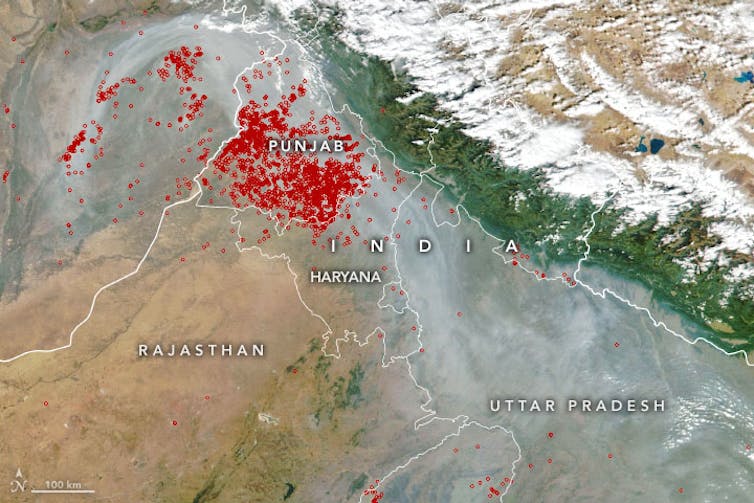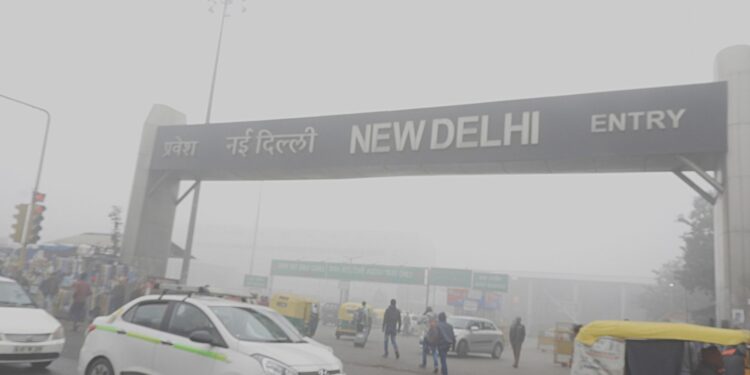Ankit Bhandekar, University of Reading and Laura Wilcox, University of Reading
Delhi is perhaps the most polluted of the world’s megacities. Every winter, the city’s 30 million residents breathe air so toxic that visibility drops to mere metres. If you stand on top of one of Delhi’s monuments you can barely make out buildings across the street as the thick, acrid smog burns your eyes and scratches your throat.
But conditions can and do change rapidly. January 2025 offered a dramatic demonstration of how weather patterns can rapidly transform the city’s air quality.
On January 5, favourable winds improved air quality enough to lift some restrictions. Yet by January 15, as winds calmed and temperatures dropped, pollution levels soared dramatically, forcing the city to implement its maximum “severe +” interventions. These include banning trucks from entering the city, restricting private vehicles and moving schools to online classes.
Delhi didn’t suddenly have more cars, factories, power plants or construction sites from one week to the next. Those things are consistent sources of pollution. There are some events that add to air pollution in the shorter term, such as fireworks during Diwali, or the mass burning of unwanted crop debris (known as stubble), both of which take place in October or November.
But that wasn’t what happened in January. Instead, the sudden reversal revealed how weather, not just emissions, dictates Delhi’s ability to breathe. Understanding this will be crucial if the city is to clean up its air.
A meteorological prison
Delhi is one of many large cities found in a flat and hugely fertile region spanning the Indian subcontinent to the south of the Himalayas. It’s known as the Indo-Gangetic plains, as it contains the floodplains of the Indus and Ganges-Brahmaputra rivers and their tributaries. More than a billion people live in this part of the world.
Delhi specifically is also bordered by another mountain range to its south, the Aravallis. While modest compared to the Himalayas, these mountains contribute to the city sitting in a natural bowl-like area, which makes it harder for pollution to disperse.
This geographical positioning means its location naturally collects airborne pollutants from surrounding agricultural areas. Even if Delhi somehow produced zero emissions, the region would still be likely to experience air quality problems during winter.

In winter, Delhi experiences “temperature inversions” where warmer air sits above colder air like a lid on a pot. This phenomenon occurs naturally in the region but is intensified by the city’s heat-trapping urban landscape. Normally, temperature decreases with height, allowing air to mix vertically, since warm air rises. Under inversion conditions, this pattern reverses and pollutants are trapped near the ground.
The height up to which pollutants can disperse, known as the “mixing height”, also dramatically reduces in winter. While summer allows mixing up to an altitude of about one kilometre, winter can compress this to just a few hundred meters, concentrating pollutants in a much smaller volume of air.
Meanwhile the Himalayas block air from flowing northward, forcing pollution to travel the entire stretch of northern India before finding an exit over the Bay of Bengal. In cities, urban structures further complicate this by creating “surface roughness”, a frictional effect that slows pollution dispersion.
Seasonal factors
There are also seasonal factors that make pollution accumulate or disperse more at certain times of year.

Delhi’s summer monsoon season runs from July to September, providing natural cleansing through rainfall. During post-monsoon months (October-November), rainfall is minimal. At the same time, wind speeds decrease, limiting ventilation. These conditions compress the atmospheric boundary layer — the lowest part of atmosphere influenced by Earth’s surface — trapping pollutants near ground level.
Throughout winter (December-February), cooler surface temperatures intensify temperature inversions. This creates lots of fog, which combines with pollutants in the atmosphere to form Delhi’s characteristic smog. The reduced mixing height during this period severely restricts vertical dispersal of pollutants.
In pre-monsoon months (March-May), strong westerly winds can blow additional dust from the Thar Desert and agricultural regions toward Delhi. However, higher temperatures increase vertical mixing, improving overall dispersion despite this additional dust.
Season-specific approach
India’s technological interventions, including smog towers and anti-smog guns,have shown limited effectiveness in addressing the causes of pollution. Even more ambitious proposals such as using cloud seeding to induce precipitation aren’t very practical. Cloud seeding is expensive, can only cover a limited area, and needs very specific meteorological conditions.

To manage its air quality, Delhi needs a season-specific approach that anticipates weather patterns and pulses in emissions. Getting ahead of the smog could involve a few different things.
Preventive planning would mean implementing stricter emission controls before the cold, still winter days when fog is likely, rather than reacting after pollution has already accumulated.
It would involve solutions that span the whole of the Indo-Gangetic plains, rather than focusing just on Delhi (or indeed any other individual urban centre). After all, many of India’s most polluted cities share the same weather conditions, and the long-range transport of pollution can play a huge role.
A season-specific approach would mean some fixed seasonal policies would instead adapt to forecast meteorological conditions. For instance, construction restrictions (building dust is a big source of air pollution) might be tightened when inversions are predicted, even on seemingly clear days.
Finally, by combining meteorological and air quality monitoring, authorities could provide targeted warnings and interventions days before visible pollution accumulates.
Understanding these natural constraints isn’t just an academic exercise – it’s essential for developing effective policies that can protect millions of residents year-round. As climate change potentially alters these meteorological patterns, the need for scientifically informed policy becomes even more critical.
Ankit Bhandekar, Research Student — Atmosphere, Oceans and Climate, University of Reading and Laura Wilcox, Associate Professor, National Centre for Atmospheric Science, University of Reading
This article is republished from The Conversation under a Creative Commons license. Read the original article.











